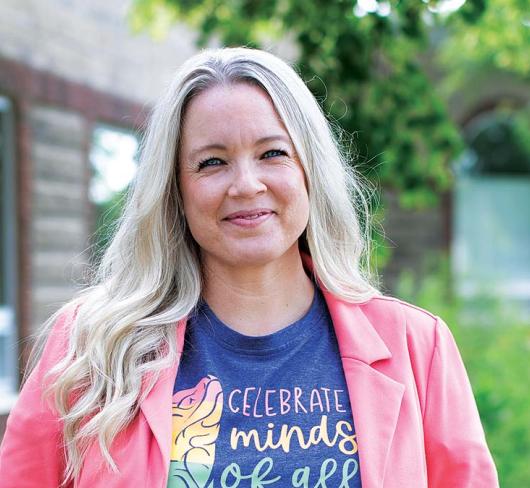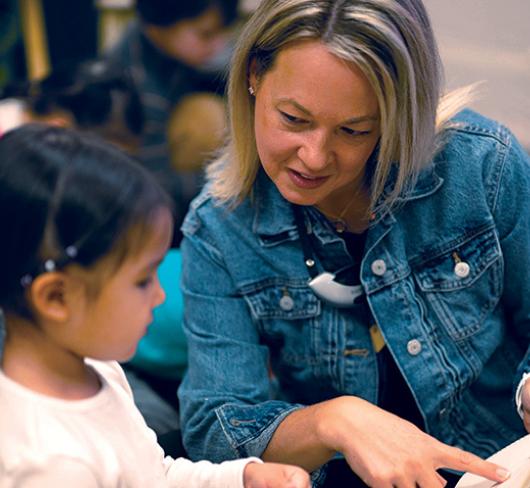
Building Better Schools: ETFO's Vision for Education Reform (Ideas)
To refresh the government’s agenda and develop her own brand as Liberal Party leader, Premier Kathleen Wynne is spearheading a number of public consultations.
The Ministry of Education launched its consultation with the publication of Building the Next Phase in Ontario’s Education Strategy. ETFO’s submission is based on its 2011 document Building Better Schools.
The government has a timely opportunity to review the last decade and introduce meaningful education reforms that reflect what both classroom educators and the latest research are saying. It’s up to the government whether it uses the consultations to genuinely review policy.
Getting from Great to Excellent
Getting from “great to excellent” is how education advisor Michael Fullan describes the overarching goal of the Ministry’s consultation exercise. The slogan acknowledges that Ontario has a strong public school system, one of the highest-performing in the world, as measured by the international student assessments conducted by the Organization for Economic Development and Co-operation (OECD). ETFO’s approach to the policy review is to identify barriers Ontario’s schools face in sustaining their high-performing status and ensuring that students develop the higher-order skills that experts say are necessary in an increasingly global and technological world.
Retooling Student Assessment
ETFO has persistently challenged the student assessment model administered by the Education Quality and Accountability Office (EQAO). The federation has vigorously fought against the extent to which the testing has narrowed the classroom focus to literacy and numeracy. Recently, ETFO has rung alarm bells about how data-driven initiatives are hampering teachers’ ability to deliver a holistic curriculum and to more consistently engage students in meaningful learning.
It is unlikely the government will totally abandon EQAO tests. As a first step, ETFO advocates moving to a random-sample testing model. Random-sample testing would transform EQAO assessments by measuring the education system, not individual students. It would mean the end to the Fraser Institute’s ranking of schools. It would give teachers more ability to exercise their professional judgement regarding the use of assessment strategies.
The random-sample model is supported by education experts like Pasi Sahlberg (1) from Finland, and Andy Hargreaves and Dennis Shirley, (2) who have conducted extensive research in both Ontario and Alberta. It is also supported by People for Education, the Ontario-based education research and advocacy organization.
Engaging Students
There is a general consensus that, to be successful in their future careers and to become responsible citizens, students need to develop higher-order skills like critical thinking, problem solving, communications, creativity, and the ability to work collaboratively. In the context of a global economy and the omnipresence of rapid technological change, our future graduates need to be self-directed, lifelong learners who are innovative, flexible, resourceful, and resilient.
To foster these higher-order skills by giving students greater opportunities to explore topics more deeply, ETFO proposes reducing the prescriptive nature and breadth of the curriculum. The play-based curriculum for the new full-day kindergarten program is already showing positive results for Ontario’s four and five-year-olds. ETFO recommends extending the experiential learning approach used in kindergarten to other elementary grades.
Creating classrooms that excite and inspire students requires correcting the overemphasis on literacy and numeracy and engaging students through the arts and more hands-on learning. ETFO is calling for the re-establishment of family studies and design and technology in grades 7 and 8. It also recommends increasing funding for teacher-librarians and specialist teachers to support the arts, guidance, and physical and health education.
Establishing Optimal Learning Environments
Educators can’t create optimal learning conditions if they have large classes. The early research on Ontario’s Primary class-size policy (3) demonstrates that smaller classes enable teachers to provide more individual attention to students and to employ a greater variety of instructional strategies. Students with the greatest educational needs benefit the most from smaller classes, but the improved learning environment benefits all students. Smaller classes have contributed to improved student behaviour and peer relationships. These outcomes contribute to improved student engagement and achievement in the early grades. These factors, in turn, lead to increased graduation rates.
The Ontario research indicates that the policy could have even greater impact if better supported by teacher in-service. The Ministry of Education’s professional development budget is one of the unfortunate casualties of the recent across-the-board cuts.
To extend the benefits documented in the Primary grades to all elementary students, ETFO is calling for reducing class size in grades 4 to 8 and the full-day kindergarten program. With both a teacher and a designated early childhood educator assigned to the kindergarten program, the average adult-child ratio is 1:13. However, many kindergarten classes have closer to 30 students and ETFO members report they are unable to effectively implement play-based learning activities with that many students and within the physical space provided.
Smaller class sizes is an expensive policy and the target of the 2011 Report of the Commission on the Reform of Ontario’s Public Services (Drummond Report), which looked, among other things, for savings in the education sector. Class-size policy on its own can’t serve as a “silver bullet” to transform student achievement levels. Small classes are, however, at the heart of educators’ ability to engage students and meet their individual needs. It would be counterproductive for Ontario to step away from supporting smaller classes before there is more longitudinal research available.
Supporting Classroom Professionals
The most consistent research findings about student success point to the role of classroom educators. (4) Teachers and other education professionals must be at the centre of any system reform. Schools must be viewed as learning organizations that support self-directed learning and collaborative professional learning communities. In Ontario, we have exemplary models of self-directed professional learning including ETFO’s Teachers Learning Together (TLP) and Reflections on Practice (ROP), and the Ministry’s Teacher Learning and Leadership Program for Experienced Teachers (TLLP). The philosophy underlying these programs needs to be embedded throughout professional learning.
In Ontario, teachers’ experience with professional learning communities has been largely through narrow-focused, top-down professional learning tied to school-based literacy and numeracy assessment data. Teachers need to be able to form their own professional learning communities and determine their own priorities based on their current classroom, their understanding of their students, and their professional needs. Most importantly, educators need to have the time during the instructional day to participate in this collaborative professional learning.
Making Schools More Inclusive
Meeting the needs of special education students is a constant challenge. The number of students being identified through the special needs identification process is increasing, not decreasing. There is a particular increase in the number of students with autism spectrum disorder. To successfully integrate special needs students into regular classrooms, it is important to provide additional professional support from educational assistants, behavioural counsellors, psychologists, and speech and language pathologists.
Ontario’s demographic profile has changed dramatically over the past decade. The number of children who speak neither English nor French when they register for school has increased significantly. Seventy-two percent of English elementary schools have English language learners (ELL) compared to 43 percent in 2002-03. (5) These students face significant challenges in catching up to their peers and schools do not have the resources to adequately support them. The provincial grants for ELL students are based on census figures related to immigrants who speak languages other than English or French. They don’t reflect the number of students born in Canada who don’t learn either official language at home before enrolling in school. The grants also assume that ELL students won’t require special language programs for longer than four years, an assumption that is not supported by reports from teachers or research on language acquisition. (6)
Addressing Schools’ Broader Context
To truly address student success, we need to look beyond the walls of our schools. Much of what affects students’ ability to do well is linked to broader social and economic issues. OECD reports demonstrate that countries with smaller gaps in income inequality have higher student achievement levels. (7). The OECD has attributed Canadian students’ high achievement scores on international assessments, in part, to the narrow income gap and number of social programs that support economically disadvantaged Canadians. However, Canada is poised to lose that advantage in the face of a widening income gap. Lower family incomes mean many students arrive at school hungry and unable to fully engage in learning. School nutrition programs only partially meet the need, and they can be stigmatizing and short-term. The federal government has a role to play in addressing this problem, but Ontario can do its part by investing more in anti-poverty strategies. These include more accessible regulated child care, more generous income support programs, and tax reforms to distribute economic prosperity more evenly in the province. Such tax reforms are also a prerequisite to supporting ETFO’s vision for education reform.
The government is devoting significant time and resources to consulting on how to make schools better. ETFO is working to ensure the effort produces positive results.
Notes:
1. P. Sahlberg. (2011). Finnish Lessons: What can the world learn from educational change in Finland.
2. A. Hargreaves and D. Shirley. (2009). The Fourth Way: The Inspiring Future for Educational Change.
3. N. Bascia B. and E. Fredua-kwarteng. (2008). Class Size Reduction: What the Literature Suggests about What Works.
4. See for example A. Hargreaves and M. Fullan. (2012). Professional Capital: Transforming Teaching in Every School.
5. People for Education. (2013). Mind the Gap: Inequality in Ontario Schools.
6. J. Cummins. (2012). Teaching English Language Learners. Research for Teachers, No. 9.
7. OECD. (2012). Ontario: Harnessing the Skills for Tomorrow. Strong Performers and Successful Reformers
in Education Lessons from Pisa to Japan.

